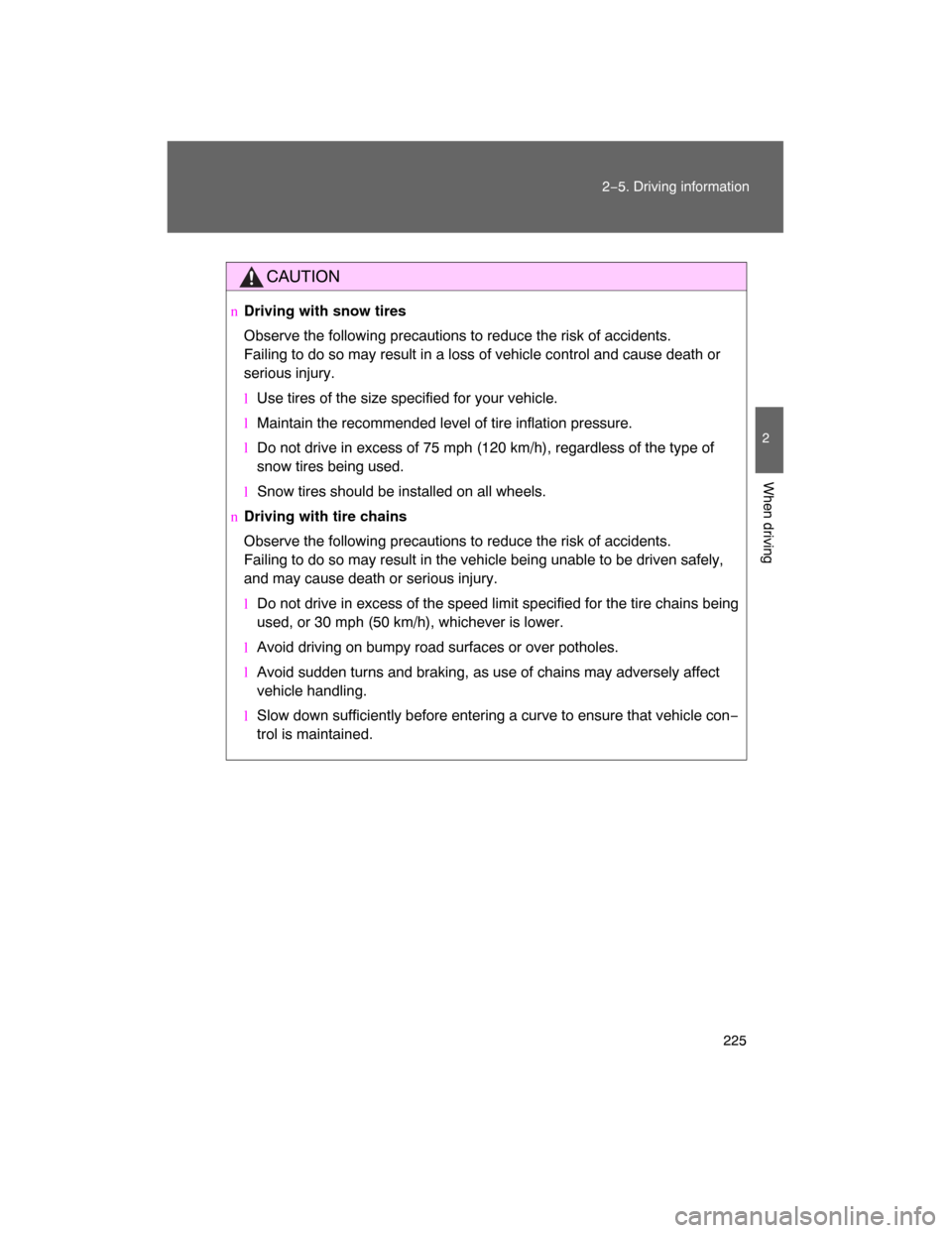Page 223 of 531

225
2−5. Driving information
2
When driving
CAUTION
nDriving with snow tires
Observe the following precautions to reduce the risk of accidents.
Failing to do so may result in a loss of vehicle control and cause death or
serious injury.
lUse tires of the size specified for your vehicle.
lMaintain the recommended level of tire inflation pressure.
lDo not drive in excess of 75 mph (120 km/h), regardless of the type of
snow tires being used.
lSnow tires should be installed on all wheels.
nDriving with tire chains
Observe the following precautions to reduce the risk of accidents.
Failing to do so may result in the vehicle being unable to be driven safely,
and may cause death or serious injury.
lDo not drive in excess of the speed limit specified for the tire chains being
used, or 30 mph (50 km/h), whichever is lower.
lAvoid driving on bumpy road surfaces or over potholes.
lAvoid sudden turns and braking, as use of chains may adversely affect
vehicle handling.
l
Slow down sufficiently before entering a curve to ensure that vehicle con−
trol is maintained.
Page 234 of 531

236 2−5. Driving information
nBefore towing
Check that the following conditions are met:
lThe vehicle’s tires are properly inflated.
lTrailer tires are inflated according to the trailer manufacturer ’s recom−
mendation.
lAll trailer lights work.
lAll lights work each time you connect them.
lThe trailer ball is set up at the proper height for the coupler on the trailer.
lThe vehicle remains level when a loaded or unloaded trailer is hitched.
Do not drive if the vehicle is not level, and check for improper tongue
load, overloading, worn suspension, or other possible causes.
lThe trailer cargo is securely loaded.
lThe rear view mirrors conform to all applicable federal, state/provincial or
local regulations. If they do not, install rear view mirrors appropriate for
towing purposes.
nBreak�in schedule
Toyota recommends that you do not use a new vehicle or a vehicle with any
new power train components (engine, transmission, differential, wheel bear−
ings, etc.) to tow a trailer for the first 500 miles (800 km) of driving.
nMaintenance
lIf you tow a trailer, your vehicle will require more frequent maintenance
due to the additional load. (See “Scheduled Maintenance Guide” or
“Owner ’s Manual Supplement”.)
lRetighten the fixing bolts of the towing ball after approximately 600 miles
(1000 km) of trailer towing.
Page 364 of 531
369
4−2. Maintenance
4
Maintenance and care
Vehicle exterior
Items Check points
Doors�Operate smoothly?
Engine hood�The lock system works properly?
Fluid leaks�Is there any leakage after park−
ing?
Ti re�Inflation pressure is correct?
�Tire surfaces not worn or dam−
aged?
�Tires rotated according to the
maintenance schedule?
�Wheel nuts are not loose?
CAUTION
nIf the engine is running
Turn off the engine and ensure that there is adequate ventilation before per−
forming maintenance checks.
Page 367 of 531
372 4−3. Do−it−yourself maintenance
ItemsParts and tools
Power steering fluid (
P. 386)�Automatic transmission fluid
DEXRON
®II or III
�Rag or paper towel
�Funnel (used only for adding
power steering fluid)
Radiator and condenser (P. 383)
Tire inflation pressure (P. 401)�Tire pressure gauge
�Compressed air source
Washer fluid (P. 390)�Water
�Washer fluid containing antifreeze
(for winter use)
�Funnel (used only for adding
washer fluid)
Page 386 of 531
391
4−3. Do−it−yourself maintenance
4
Maintenance and care
Tires
Replace or rotate tires in accordance with maintenance sched�
ules and treadwear.
nChecking tires
New tread
Treadwear indicator
Worn tread
The location of treadwear
indicators is shown by the
“TWI” or “
” marks, etc.,
molded on the sidewall of
each tire.
Check spare tire condition
and inflation pressure if not
rotated.
nTire rotation
Rotate the tires in the order
shown.
To equalize tire wear and
extend tire life, Toyota recom−
mends that tire rotation is
carried out at the same inter−
val as tire inspection.
Do not fail to initialize the tire
pressure warning system
after tire rotation.
nThe tire pressure warning system
Your Toyota is equipped with a tire pressure warning system that
uses tire pressure warning valves and transmitters to detect low
tire inflation pressure before
serious problems arise. (
P. 452)
Front
Page 388 of 531

393
4−3. Do−it−yourself maintenance
4
Maintenance and care
Initializing the tire pressure warning system
nThe tire pressure warning system must be initialized in the fol�
lowing circumstances:
lWhen rotating the tires on vehicles differing with front and rear
tire inflation pressures.
lWhen changing the tire inflation pressure by changing traveling
speed or load weight, etc.
lWhen changing the tire size.
When the tire pressure warning system is initialized, the current
tire inflation pressure is set as the pressure benchmark.
n
How to initialize the tire pressure warning system
Park the vehicle in safe place and turn the “ENGINE START
STOP” switch to OFF mode.
While the vehicle is moving, initialization is not performed.
Adjust the tire inflation pressure to the specified cold tire infla−
tion pressure level. (
P. 502)
Make sure to adjust the tire pressure to the specified cold tire
inflation pressure level. The ti
re pressure warning system will
operate based on this pressure level.
Turn the “ENGINE START STOP” switch to IGNITION ON
mode.
STEP1
STEP 2
STEP 3
Page 390 of 531

395
4−3. Do−it−yourself maintenance
4
Maintenance and care
Registering ID codes
The tire pressure warning valve and transmitter is equipped with a
unique ID code. When replacing a tire pressure warning valve and
transmitter, it is necessary to regi ster the ID code of tire pressure
warning valve and transmitter. Have the ID code registered by your
Toyota dealer.
n When to replace your vehicle’s tires
Tires should be replaced if:
lYou have tire damage such as cuts, splits, cracks deep enough to
expose the fabric or bulges indicating internal damage
lA tire goes flat repeatedly or c annot be properly repaired due to the
size or location of a cut or other damage
If you are not sure, consult with your Toyota dealer.
n Replacing tires and wheels
If the ID code of the tire pressure warning valve and transmitter is not
registered, the tire pre ssure warning system will not work properly. After
driving for about 20 minutes, the ti
re pressure warning light comes on
after blinking for 1 minute to indicate a system malfunction.
n Tire life
Any tire over 6 years old must be checked by a qualified technician even
if they have seldom or never been used or damage is not obvious.
n If the treadwears down below 0.16 in. (4 mm) on snow tires
The effectiveness of snow tires is lost.
Page 391 of 531

396 4−3. Do−it−yourself maintenance
nMaximum load of tire
Check that the maximum load of the re
placed tire is greater than 1/2 of
the Gross Axle Weight Ratings (GAWR) of either the front axle or the
rear axle, whichever is greater.
As for the maximum load of the tire, see the load limit at maximum cold
tire inflation pressure mentioned on the sidewall of the tire, and as for the
Gross Axle Weight Ratings (GAWR)
, see the Certification Label. ( P.
401, 507).
nTire types
1 Summer tires
Summer tires are high−speed performance tires best suited to highway
driving under dry conditions. Sinc
e summer tires do not have the same
traction performance as snow tire s, summer tires are inadequate for
driving on snow−covered or icy roads. For driving on snow−covered
roads or icy roads, the use of
snow tires is recommended. When
installing snow tires, be sure to replace all four tires.
2 All season tires
All season tires are designed to prov ide better traction in snow and to
be adequate for driving in most winter conditions, as well as for use
year round. All season tires, however, do not have adequate traction
performance compared with snow tires in heavy or loose snow. Also,
all season tires fall short in acceleration and handling performance
compared with summer tires in highway driving.
3Snow tires
For driving on snow−covered roads or icy roads, we recommend using
snow tires. If you need snow tires,
select tires of the same size, con−
struction and load capacity as the or iginally installed tires. Since your
vehicle has radial tires as original equipment, make sure your snow
tires also have radial construction. Do not install studded tires without
first checking local regulations for possible restriction. Snow tires
should be installed on all wheels. (
P. 222)